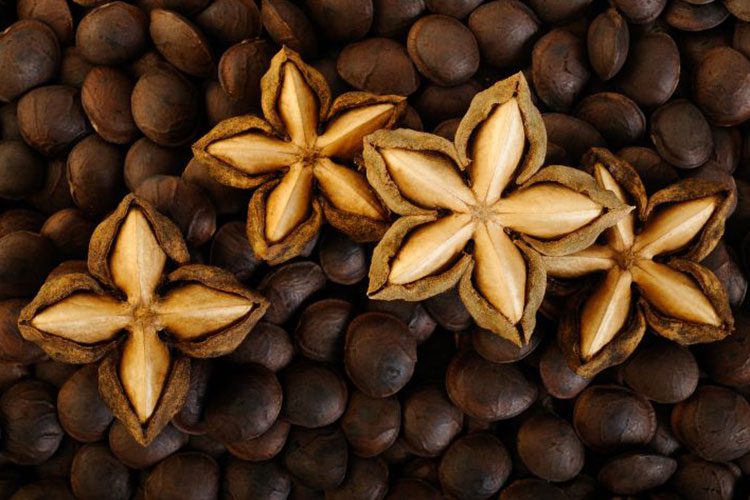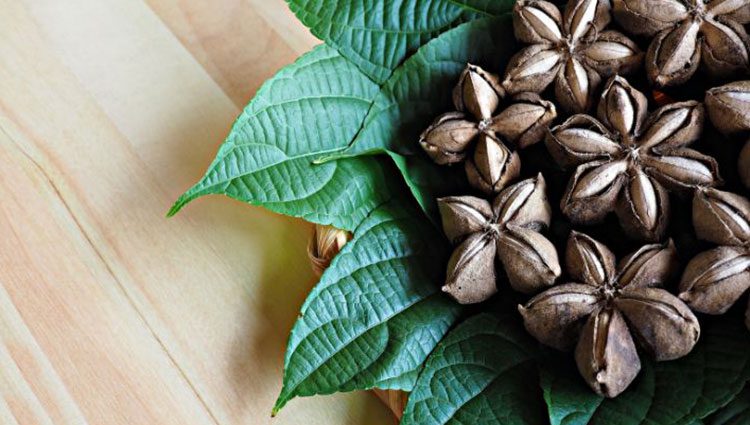
We live in a world where so many people are discussing the subject of wholistic nutrition. In particular, the human need of Omega-3 essential fatty acids and complete protein has come into the limelight. Do we really need to eat fish and meat to stay healthy or “be a man”? Can something in nature supply us with what the body requires without sacrificing animals? Yes, indeed! Sacha Inchi will come to the rescue!
Peanut Protein Alternative

This all-star seed has been making the headlines for several years now, and for good reason. With its geometric star-shaped seed pod, the perennial plant come originally from South America and Southeast Asia. (1)
Sacha Inchi, also known as Inca or Mountain Peanuts, are botanically seeds, though they are typically called and utilized as nuts. Each pod contains anywhere from 4-7 seeds. In fact, the plant is technically a drupe, but don’t worry if that’s news to you. What you may already be privy to is the problem peanuts can pose in society. Peanuts are “the most common food allergy in children under age 18 and the third-most common food allergy in adults.” (2)
Not to worry, Sacha Inchi to the rescue! The seeds, when toasted and salted, resemble a very peanut-like flavor. And not only do you get to mimic the taste, but the protein content exceeds that of peanuts by 20% at 8.5 grams per ounce, compared to only 7. (3)
The only seed with a higher protein content is hempseed, which contains 10 grams. However, Sacha Inchi has a greater proportion of each branched-chain amino acid, making it a higher quality overall. This makes it a great protein alternative for those attempting to avoid soy-derived protein sources. (4)
Nothing Fishy Here
Yes, raw sacha inchi may not necessarily be “love at first bite.” Maybe, though, that slightly fishy aftertaste hints to its high omega-3 fatty acid content. High in alpha linoleic acid — the plant-based omega 3 — sacha inchi has benefits similar to fish oils. The biggest benefit of fish oil is omega 3s by far. But what if you want the same omegas without a mega sea die-off? Once again, sacha inchi to the rescue! Peer-reviewed research has found that this plant is as much as 44% linoleic acid! That’s like flax oils but without the phytoestrogens. (5)
So hold the fish, please! (And the flax.)
Not only that, but it offers that healthy dose of both linoleic acid and alpha-linolenic acid. And this is separate from any possible heavy metal ocean pollution that typically bioaccumulates in marine life. The United States Federal government issued an advisory warning to pregnant women to eat no more than 2 portions of seafood per week due to mercury toxicity. (6, 7)
Nothing to worry about if you choose Sacha Inchi as your substitute. A rare human clinical trial found that a 4-month long consumption of the seed oil corresponded to lower levels of triglycerides and non-esterified fatty acids, as well as higher “good” HDL cholesterol and insulin levels. (8)
The body will take these omegas from plant foods and, through a process of conversion, transform them into the EPA and DHA utilized by our bodies. (9)

“The reason fish – even organic and farm raised – are so problematic is because of how their biology works. Even if they’re not contaminated, the food they eat might be and a significant portion of that will stay in their system.” (10)
Emotional Health
Tryptophan is an amino acid that is essential, meaning it must be derived from the diet. It is also a precursor to serotonin, the “feel good” neurotransmitter, and Sacha Inchi is loaded with it. (11)
Thus, it contributes to calming the nerves, elevating mood, and helping you adapt to stress, anxiety, and depression. (12)
Also, when it comes to cancer, sacha inchi comes to the rescue once more. “Sacha Inchi leaves have shown antioxidant and antiproliferative activities against certain cancer cells but were nontoxic to normal cells.” (13)
How To Use Sacha Inchi
Enjoy this rescue seed in a variety of neat ways. Toss a palm full in a bowl of granola or trail mix for a flavorful breakfast. Grind up a cup of toasted seed in a blender for a naturally protein-rich smoothie. (13)
Lather the nutrient-dense oil onto your scalp after a shower for optimal hair health and collagen formation. (14)
Or chew some as an after-meal dessert for improving the Lactobacillus microbiota in the gut with its prebiotic fiber.
The point is to just always have it on hand as much as possible. Why? Because it may save you when you need it the most!
Please do take caution in consuming, though, if you do have a confirmed peanut allergy.
You can find Sacha Inchi Powder here for your own concoctions (tastes great in chocolate!). Or enjoy the protein punch in Vanilla and Chocolate flavors of Global Healing’s Organic Pure Plant Protein Powder.



